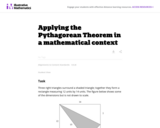
This task requires students to apply the Pythagorean Theorem.
- Subject:
- Geometry
- Mathematics
- Material Type:
- Activity/Lab
- Provider:
- Illustrative Mathematics
- Provider Set:
- Illustrative Mathematics
- Author:
- Illustrative Mathematics
- Date Added:
- 05/01/2012

This task requires students to apply the Pythagorean Theorem.
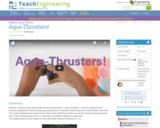
In this activity, students construct their own rocket-powered boat called an "aqua-thruster." These aqua-thrusters will be made from a film canister and will use carbon dioxide gas produced from a chemical reaction between an antacid tablet and water to propel it. Students observe the effect that surface area of this simulated solid rocket fuel has on thrust.
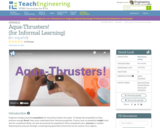
Students build rocket-powered model boats using film canisters.
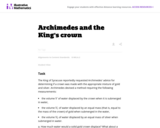
The famous story of Archimedes running through the streets of Syracuse (in Sicily during the third century bc) shouting ''Eureka!!!'' (I have found it) reportedly occurred after he solved this problem. The problem combines the ideas of ratio and proportion within the context of density of matter.
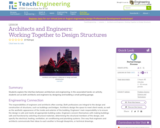
Students explore the interface between architecture and engineering. In the associated hands-on activity, students act as both architects and engineers by designing and building a small parking garage.

In this problem, students are given a picture of two triangles that appear to be similar, but whose similarity cannot be proven without further information. Asking students to provide a sequence of similarity transformations that maps one triangle to the other focuses them on the work of standard G-SRT.2, using the definition of similarity in terms of similarity transformations.
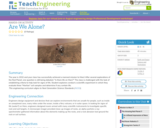
The year is 2032 and your class has successfully achieved a manned mission to Mars! After several explorations of the Red Planet, one question is still being debated: "Is there life on Mars?" The class is challenged with the task of establishing criteria to help look for signs of life. Student explorers conduct a scientific experiment in which they evaluate three "Martian" soil samples and determine if any contain life.
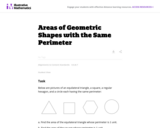
This problem is part of a very rich tradition of problems looking to maximize the area enclosed by a shape with fixed perimeter. Only three shapes are considered here because the problem is difficult for more irregular shapes.
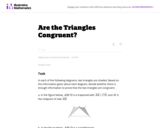
The purpose of this task is primarily assessment-oriented, asking students to demonstrate knowledge of how to determine the congruency of triangles.
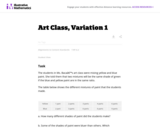
This this task about mixing paint requires students to graph ratios on a coordinate plane. It is a standard language in ratio problem.
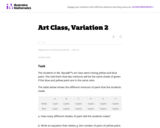
This this task about mixing paint requires students to graph ratios on a coordinate plane. It is a standard language in ratio problem.

Students learn more about how muscles work and how biomedical engineers can help keep the muscular system healthy. Following the engineering design process, they create their own biomedical device to aid in the recovery of a strained bicep. They discover the importance of rest to muscle recovery and that muscles (just like engineers!) work together to achieve a common goal.
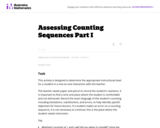
This activity is designed to determine the appropriate instructional level for a student in a one-on-one interaction with the teacher.
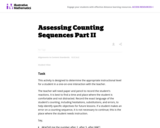
This activity is designed to determine the appropriate instructional level for a student in a one-on-one interaction with the teacher.
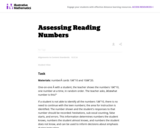
In this assessment in a one-to-one setting, a student is shown the numbers from 1Đ10, one number at a time, in random order. The teacher asks, Ňwhat number is this?"
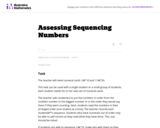
This assessment task can be used with a single student or a small group of students. Each student needs his or her own set of numeral cards.
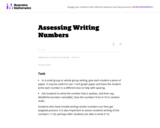
This assessment may be used in a small group or whole group setting, give each student a piece of paper. Students who have trouble writing certain numbers can then get targeted practice.

Astronomy for Educators provides new and accomplished K-12 instructors with concepts and projects for low-cost, high-impact STEM classroom instruction that is built around the National Academies National Research Council's K-12 Framework for Science Education.
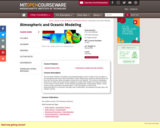
The numerical methods, formulation and parameterizations used in models of the circulation of the atmosphere and ocean will be described in detail. Widely used numerical methods will be the focus but we will also review emerging concepts and new methods. The numerics underlying a hierarchy of models will be discussed, ranging from simple GFD models to the high-end GCMs. In the context of ocean GCMs, we will describe parameterization of geostrophic eddies, mixing and the surface and bottom boundary layers. In the atmosphere, we will review parameterizations of convection and large scale condensation, the planetary boundary layer and radiative transfer.
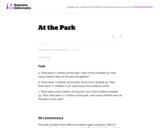
These 3 word problems require students to solve addition and subtraction problems.